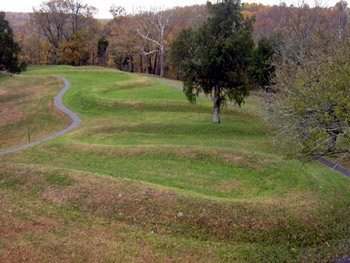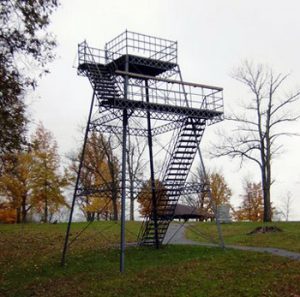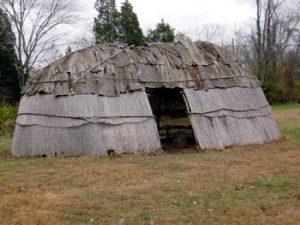
Ohio, USA
by Al Bruning
The rolling hills of Southern Ohio surround me in all directions. My husband and I travel along the secluded wilderness below the Great Serpent Mound. From head to tail the Serpent measures 1,330 feet in length and three feet in width. It dwells high above a 100 foot bluff overlooking Brush Creek commanding reverence and respect. Our car journeys up the back country road into the park. My heart beats faster. I can’t wait to stand beside this wondrous creature.
Delaware and Iroquois legends speak of the Allegheny people, who lived in the Ohio wilderness before the mounds, built the Serpent Mound. Yet academics disagree. The Serpent Mound withstood the test of time since the Fort Ancient people completed the magnificent creature in 1070A.D. The Fort Ancient culture connected their lives to the land and the sky above them.
In winter of 1053 A.D, a severe weather came upon the Southern Ohio wilderness. The storm reduced the abundant nut crop. Hordes of starving red, black and grey squirrels ran north the following spring. They caused havoc upon village crops. Fort Ancient farmers experienced devastation and starvation. April of 1054, light from the supernova that created the Crab Nebula erupted over the skyline. Visible night and day for two weeks, the Fort Ancient took notice. Autumn came, the local population burned trees and tobacco. Upon the cleared land they began construction of the mound, believing the light in the sky saved them from the spooked squirrels. Eleven years later, the brightest view of Halley’s Comet ever witnessed followed a path over the sight of Serpent Mound. The Fort Ancient placed a pile of burnt rocks by the serpent’s mouth to honor the flying serpent with rays of fire.
My husband and I walk out of the parking lot towards the visitor’s center on our left and enter the museum. We wind our way through the small museum. The exhibits introduce us to the people who called the area their home. We learn about the famous archaeologists who worked on the mound. The information gleaned from their expeditions tells the story of a time once lost and leaves us with wonder.
 Out the door of the museum we follow the asphalt trail around the perimeter of the mound. Soon we approach the tall, black, metal, observation tower overlooking the Serpent Mound. Like an energetic child, my husband ascends the stairs. He beckons for me to follow him. I hesitate. What if I fall over? I place my fears aside and ascend to the second landing. My eyes peer up and down the serpents coils. Curiosity fills me. I anxiously climb the stairs higher until I reach the top. The serpents’ body coils seven times before me. Each coil perfectly aligned to a specific yearly astronomical event; the head to the setting sun of the summer solstice and the twisting coils to the sunrises of both solstices and the equinoxes. I marvel at the astronomical knowledge the Fort Ancient people possessed. Surely this site held spiritual significance.
Out the door of the museum we follow the asphalt trail around the perimeter of the mound. Soon we approach the tall, black, metal, observation tower overlooking the Serpent Mound. Like an energetic child, my husband ascends the stairs. He beckons for me to follow him. I hesitate. What if I fall over? I place my fears aside and ascend to the second landing. My eyes peer up and down the serpents coils. Curiosity fills me. I anxiously climb the stairs higher until I reach the top. The serpents’ body coils seven times before me. Each coil perfectly aligned to a specific yearly astronomical event; the head to the setting sun of the summer solstice and the twisting coils to the sunrises of both solstices and the equinoxes. I marvel at the astronomical knowledge the Fort Ancient people possessed. Surely this site held spiritual significance.
I descend the stairs, traverse down the winding path, then pause in front of the serpents head. I try to catch a glimpse of the whole serpent lengthwise. Its quarter mile long body winds along the hill. The cliff behind me offers a view of the wilderness below my feet. Brush Creek sits in the tree covered valley. I can hear the gentle wind blow through the green trees. Wildlife roams towards the water. A half mile trail makes it way down the cliff I stand upon to Brush Creek. Closed due to weather, my heart breaks. My walk takes me to the end of the Serpent Mound. Three stone steps invite me to gaze into the interior circle of the tail. I marvel at the conical structure then leave the Serpent behind me.
Farther I walk through the park, past a few Adena burial mounds. The low hilltop, grass covered ground engages my thoughts. I wonder how many times, people walk over a mound and never know it’s there. Stories from early Kentucky and Ohio explorers speak of mounds differing in shapes and sizes. Settlers and farmers destroyed the mounds in effort to clear the lands. A rich history gone forever. These preserved Adena mounds capture a history we know so little about.
 I continue my walk across the large field. To might left sits the recreation of a Woodland Period home. I step back in time. My feet carry me inside the wood and bark oval house. Ceramic corn, squash, and gourds hand from the wooden beams. Wooden cots cling to the side serving both bed and table. Doors on both sides, covered with hides in the winter, welcome family and visitors. I step outside the house and turn right. A fireplace lies on the ground by my feet with a wooden shelter behind it. Burnt wood and charcoal lie in the fireplace. In my mind I see the wife cooking, her children run free around the garden and home while her husband sits under the shelter making tools. I gaze to my right. The wife’s simple garden sits off to the side. Everything the family needs, nature provides. Her garden grants the family squash, corn and gourds. Her husband hunts deer and other mammals for meat. The surrounding wilderness provides wood for fuel and building. Brush Creek provides drinking water, fish, and waterfowl. Her husband uses the rocks from the creek to make his weapons. Her children learn from an early age how to survive.
I continue my walk across the large field. To might left sits the recreation of a Woodland Period home. I step back in time. My feet carry me inside the wood and bark oval house. Ceramic corn, squash, and gourds hand from the wooden beams. Wooden cots cling to the side serving both bed and table. Doors on both sides, covered with hides in the winter, welcome family and visitors. I step outside the house and turn right. A fireplace lies on the ground by my feet with a wooden shelter behind it. Burnt wood and charcoal lie in the fireplace. In my mind I see the wife cooking, her children run free around the garden and home while her husband sits under the shelter making tools. I gaze to my right. The wife’s simple garden sits off to the side. Everything the family needs, nature provides. Her garden grants the family squash, corn and gourds. Her husband hunts deer and other mammals for meat. The surrounding wilderness provides wood for fuel and building. Brush Creek provides drinking water, fish, and waterfowl. Her husband uses the rocks from the creek to make his weapons. Her children learn from an early age how to survive.
A hard and simple life drastically different from modern day America, yet our nation knew this life long before Europeans came. I take in my visit to past with greater appreciation. Our ancestors walked these lands with their lives connected to the world around them. Their beliefs shaped their lands. The land forever shaped their lives. Late in the day it’s time to leave this place. I say goodbye to my new discoveries.
If You Go:
Serpent Mound State Park operates under the Arc of Appalachia Preserve System. The park operates year round. Hours of operation vary between seasons. The park charges a $7 personal vehicle, $2 motorcycle, and $9 RV parking fee. They honor a $1 discount for AAA members and half price for active military. Friends of the Serpent Mound, a volunteer group associated with park, offer several special events throughout the year. For more information visit www.highlandssanctuary.org
About the author:
An Ohio native, Al Bruning lives on a 1.3 acre Holland Lop rabbitry outside of Bedford, Kentucky. Her interest in Ohio history began in childhood when she learned her family was one of the first families to settle into Ohio. In addition to her rabbit business, Al writes as the Louisville Kentucky’s cultural history examiner for examiner.com. Her articles may be viewed at www.examiner.com. She maintains her blogs at hubpages.com/emeraldkell. A writer and photographer, her range of topics vary. She enjoys travelling, history, culture, country life, and her family. She may be reached at emeraldkell@yahoo.com.
All photographs are by Al Bruning.



Leave a Reply
You must be logged in to post a comment.